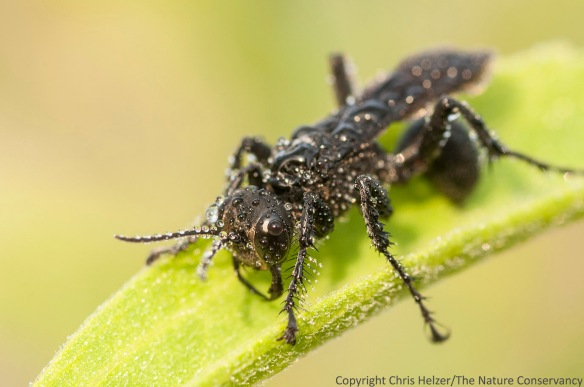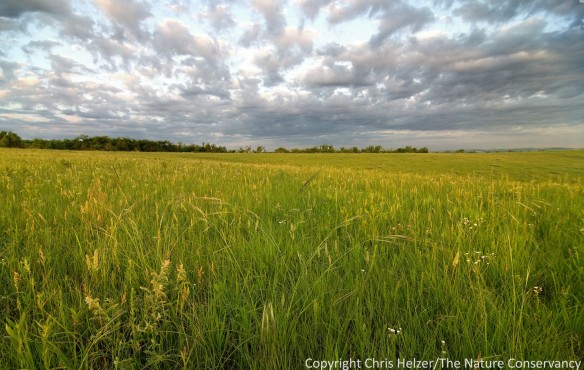It took me a long time to decide to write a book on prairie management. One of my worries was that I was learning a tremendous amount each year, and a book captures a moment in time. One of the reasons I like writing this blog is that it allows me to share lessons as I learn them, modify my ideas over time, and – best of all – get instant feedback from readers. I learn a lot from watching prairies, but I learn even more from discussions with other people who watch prairies.

Attending workshops such as the annual get-together of the Patch-Burn Grazing Working Group has helped me continue to learn at a fast rate. (2013 Workshop in South Dakota)
My prairie book came out in 2010, but I actually did most of the writing in 2008 – five years ago. By the time the final manuscript passed through reviews and layout and made it to the publishing stage, there were already a few sections I would have liked to modify. Now that five years have passed, there are even more changes I wish I could make.
Don’t get me wrong, I’m still very proud of the book, and satisfied with its contents. But reading through it recently, I picked out some portions that I would handle differently if I was writing the book today. Here are a few of those:
Page 12 – “Mycorrhizal fungi help plants fix nitrogen”. Ok, I really flubbed this one. As Inger Lamb kindly pointed out to me after the book came out, mycorrizhae help plants pull in food and water more effectively. Bacteria are what help plants fix nitrogen. I should have just skipped the whole topic in the book, given my very rudimentary knowledge of what happens belowground. In my defense, the book went through several technical reviews, and none of the reviewers caught the error either.
…On the plus side, I did manage to spell “mycorrhizal” correctly.
Insects. The insect section in the book was originally three times longer. I was urged (coerced?) by the publisher and reviewers to chop it back drastically because it was so much longer than similar sections on mammals, birds, etc. I wish I’d fought harder to keep it long. As I’ve discussed numerous times on this blog, insects and other invertebrates are WAY more diverse and important to the way prairies functions than any other group of above-ground creatures. The existing insect section in the book is a good primer on some of the insect communities of prairies and their impacts, but doesn’t go nearly far enough. Maybe I’ll write a whole book on prairie invertebrates someday. (But probably not – can you imagine how quickly THAT book would become out of date? We still have a massive amount to learn about invertebrates.)

I didn’t know much of anything about wasps a year ago, but I’m learning more now. This one is in the genus Prionyx and feeds its larvae on grasshoppers. (Thanks to Mike Arduser for that information)
Page 79 – “Managing prairies really means managing the competition between plants.” This is a nice statement, but it’s too narrow. If I was writing that now I would replace “plants” with “species”. In general, my biggest beef with my 2008 self is that I was too focused on plants, and not enough on habitat for other species.
In the prairies I know best, maintaining plant diversity appears to be dependent upon periodically suppressing dominant grasses and giving other plants a chance to thrive. Our management strategies create a dynamic disturbance regime that helps keep any single group of plants from bullying others out of the prairie. However, not all prairies work like the ones I manage. Especially in some eastern tallgrass prairies, which have abundant rainfall and deep organic soils, many prairie plant communities seem to be pretty stable without any management that suppresses grasses. For example, very frequent spring fires seem to do a fine job of maintaining populations of most plant species in some of those sites – maybe because there is less intense competition between plants when soil moisture is abundant?
While frequent fire is able to sustain diverse plant communities in some prairies, I still think the shifting mosaic of disturbances I advocated for in my book is very important. Burning an entire prairie every year creates a single habitat structure across that prairie. That’s great for the species that like that habitat structure. However, a prairie with patches of short, tall, and mixed-height structure is going to provide for more animal species than one with uniform structure. I’m convinced that creating heterogeneous habitat can be done without hurting the plant community, and I think it’s a critical component of good prairie management. So – I think my management advice in the book is still sound, I just wish I’d explained the value of it differently.

Some prairies that are annually burned or hayed (like this one) may be able to maintain plant diversity, but they provide only a limited range of habitat options for wildlife and invertebrates.
Small Prairies. I spent a little time in the book talking about the challenges of managing small prairies, but I’ve spent more time thinking about this subject during the last few years. I wrote a post that summarized much of that thinking back in March, 2012. Many prairies are small enough that providing the kind of habitat patchiness I just discussed might not be feasible or even appropriate. In the eastern tallgrass prairie, many grasslands are only a few acres in size, and much of what I talked about in the management portion of the book would be difficult to apply. I wish I could go back and put in a whole chapter that fleshes out what I discussed in my blog post.
Too bad, so sad. Those are a few of the things I’d change if I could alter my book today. Unfortunately, because of layout challenges and other issues, I can’t just add a few paragraphs or re-write a chapter and then just reprint the book. Even if I could, there’d still be a couple thousand books in people’s houses and offices preserving my out-of-date ideas forever.
I may write another book someday. I might even go back and revise the one I’ve already written, though I dread that process. In the meantime, I’m going to enjoy the opportunity to write in this blog format, which allows me to constantly adapt my ideas as I learn from prairies and from you. Thank you for helping me with that process.

Hi Chris, I wonder if the more severe effects of drought in the western tall grass region has not allowed competition to equilibrate as much as has occurred in more eastern prairies. The eastern prairies receive long term drought capable of destroying the ecosystem less frequently. The rarity of ecosystem destroying events allows the dynamic to reach a more stable state. In contrast, western prairies are always younger ecosystems developing from a more recent ecosystem altering drought. Since the ecosystem is being set back more frequently in the west, maybe it does not reach a state that is as diverse or stable?
Sincerely,
James
James,
Good question. Drought certainly has big implications, but I’m not sure how related it is to equilibrium of plant communities. I’m not saying it’s NOT related, just that I don’t know.
Hello Chris, My question made me get out my old Biology book, Campbell, fourth edition, pp. 1137-1138. I looked through the section on community ecology. There are opposing viewpoints from a climax community being at equilibrium to communities being in a continual state of flux. The part that seems to pertain to my question the most is the intermediate disturbance hypothesis. This hypothesis states that “species diversity is greatest where disturbances are moderate in both frequency and severity, because organisms typical of different successional stages will be present.”
If my take on the difference between diversity in eastern and western prairies were accurate then the view point of communities being near equilibrium or in measurable flux would depend on biogeograpy. Also, intermediate disturbance would lead to more diversity not merely because “organisms typical of different successional stages are present” (pp. 1138) but also because more moderate levels of wide spread disturbance (like drought) would give ecosystems more time for “complex population interactions to coevolve and develop to a greater extent.” (pp. 1139).
These thoughts are all very interesting. The real challenge would be to prove them experimentally.
Sincerely,
James
Chris,
Yeah wouldn’t we all like to edit our past whatever form that takes.
Make sure your blog is kept in some form so maybe it can become your next book when you are ready to retire and sit back on your laurels.
Ernie
I feel the same way you do, Chris; my book Design Your Natural Midwest Garden was published 5 years ago by Trials Books in Madison (now in Colorado) and there’s so much I wish I could change. I would like to revise it, but I also want to do another book based on the calendar of what’s in bloom or looking good at that particular time–actually what I do in my blog. I hope to figure it all out this winter.
Happy thanksgiving to you.
I’m really interested in anything I can learn about managing small prairie areas. Here in Arlington, Texas, we (the local environmental conservation group) have managed to preserve a small patch of “virgin” prairie that consists of perhaps 40 acres, surrounded by commercial developments and housing. Our chief effort to date has been to eliminate invasive species, which in this area of relatively good rainfall include everything that blows in — especially trees. Is there a good sourcebook that we might consult for managing small prairie areas? Might you be interested in writing one?
John
Hello Chris,
have you ever thought about publishing an e-book?
It would be much simpler to update from time to time, so your learning, your insights could be easily shared with others and would be much more up-to-date.
All the best for your work.
Gernot
I like this suggestion, having recently gotten into the realm of books on Kindle.
It’s a good sign that you want to revise, expand, modify, Chris. I shows that our fields of work and study are still revising, expanding, and modifying, as they must, since we are still far from knowing everything there is to know or asking everything there is to say or practicing everything there is to practice.
Actually, I see they’ve made my book into an ebook now, but I’m not sure that makes it easier to edit…
Don’t be so hard on yourself. We are all constantly learning and changing , just like the prairie, But for you to admit it is the sign of someone who is a good steward and always learning.
Sue
Chris:
I am a plant science teacher at the University of Nebraska in Agronomy and Horticulture. I am teaching a new lab to go with our entry level plant science course and I am assembling resources that my students can use to design and carry out simple experiments that give them a better insight on the biology of plants that are members of prairie ecosystems. The goal is to give them a chance to work and learn like a plant scientist through investigation. I really like the theme of your post…. learning. So often we present students the facts in biology and give them the impression that every fact has been discovered.
Don Lee
Hi Don – Thank you. I’m glad you enjoyed the post. I actually took a genetics class from you back in the early 1990’s at UNL! I enjoyed the class and learned a lot. It’s good to hear from you.